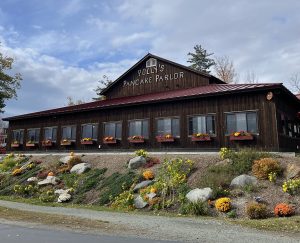
Even if you haven’t visited the White Mountains region, you may have experienced some of Scott Rice’s work. Scott is the owner of Woodstock Inn Brewery, which makes its delicious beer available across New England. However, his involvement with the community began long before he started his business.
Scott has been in the area since 1974 and shows no signs of leaving. He said, “I worked at the Jack O’ Lantern Resort during my college summers. After college in 1976 I started working as a ski instructor in Steamboat Springs, Colorado, and here in the summer until around 1980 when I decided to buy our house and go out on my own. Our community is very, very important to my wife and me and I love seeing how my kids are now following down the same path.”

You’re family too
Scott’s business is a lot like him. It’s warm, open, and focused on the best possible experience for his family, his team, his guests, and his larger community.
“We are a family business that tries to treat our employees as family and hope that they treat our customers as their family. Many of our customers have become our family over the years. We have watched them bring their infants in after skiing for a quick bite and now many of those little babies have gotten married here at the Inn. It’s a full circle.”
Scott is focused on making everyone feel at home.

Fully invested
“I have always felt strongly that we need to support the community that supports us,” said Scott. And support it he does! Scott provided me with quite a list of ways.
He said, “The whole family is involved as volunteers and of course fundraisers. My son Keegan just did a photography shoot at the Lincoln Library that received all the proceeds. We like to use our facility in the off-season to donate and support many organizations such as the Vets Rest Stop. In the past, I have been Chamber president, a member of the Governor’s Council on Tourism, a long-time town of Woodstock planning board member, and a 40-year member of the local Rotary Club. Currently, I’m a Woodstock Selectperson and President of the North Country Center For the Arts. My wife Peg is on the local senior advisory board and the Bridge Project with my daughter Molly.”
A landmark community business
Though Woodstock Inn Brewery isn’t officially designated as a landmark, it has been a mainstay of Main Street for decades and many parts of it include local history.
“The Inn started over 40 years ago when we bought the over hundred-year-old Clement house that had been deserted for almost twenty years. He was the postmaster in town before he passed. So the main building had been a Main Street fixture for many years. We renovated it and put in the first water heater.
“Previously, it was heated in a tank on top of the kerosene stove. With a lot of sweat equity, we started with four guest rooms, lived in the attic, and had thirty restaurant seats. We served breakfast and dinner on Friday and Saturday. Since then the Inn Brewery has grown organically, adapting and trying to cater to our ever-changing customers.
“Today we have 40 rooms, three houses that we rent, and 450 restaurant seats including our function room. Many years ago we moved the original railroad station from Lincoln that was going to be torn down and added more local history. Over the years all the additions have made the place quite a maze to maneuver in. Fun fact! If you walk through the bars and restaurants, a lot of the fun antiques that you see were given to us by various locals throughout the years that they found in their homes and thought we might enjoy.”
True humility
Though many of the questions we asked Scott focused on his role in the community, he regularly referred back to the value of working together as a group. This speaks directly to his character.
When asked what he thought was the most important thing to consider if someone wanted to get more involved in a local community, he said, “Having a local vibrant community is a team effort. Everyone needs to participate in organizations that support businesses and families. The senior members of our community need to work with the young families and community members to have a well-rounded group of individuals working to make our town the great place it is. There is enough business for everyone and we all need to work together to support our residents and increase visitors to our area.”

–
Scott Rice is not only a Western White Mountains Chamber of Commerce member, he’s a model community leader. We are proud to know him.

For state-wide information, head to VisitNH.gov.

Copyright (C) 2024 Western White Mountains Chamber of Commerce. All rights reserved.






























